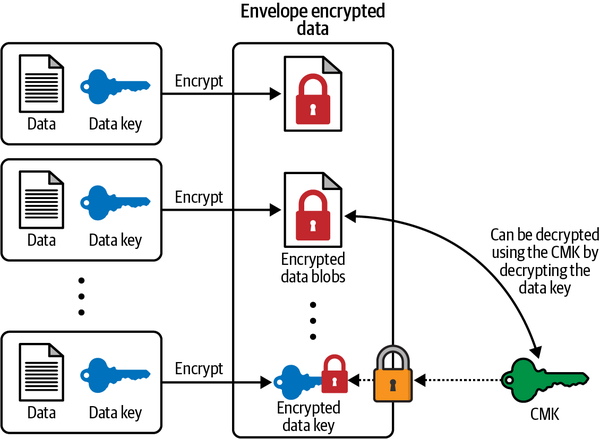

Authors: Bharath Karamudi
Envelope encryption is a method of encrypting data where the data is encrypted using a symmetric key, and the symmetric key is then encrypted using an asymmetric key. The encrypted data and encrypted symmetric key are referred to as the “envelope.”
The advantage of this approach is that the asymmetric key, which is typically used to encrypt the symmetric key, is much slower to use for encrypting and decrypting large amounts of data compared to the symmetric key. This means that the data can be quickly encrypted and decrypted using the symmetric key, while the slower asymmetric key is used only to secure the symmetric key. This makes envelope encryption particularly useful for protecting sensitive data, as it allows for fast and efficient encryption and decryption of large amounts of data without sacrificing security.
Envelope encryption is often used to secure sensitive data in cloud environments, where the data may need to be accessed by multiple parties but the security of the data key cannot be guaranteed. It provides an additional layer of security by ensuring that only authorized parties can decrypt the data, even if the data key itself is compromised.
+--------+ +--------+
| | | |
| User | | KMS |
| | | |
+--------+ +--------+
| |
(Encryption) | Generate data key (DEK) |
|---------------------------->
| |
| DEK (plaintext and |
| ciphertext) |
|<----------------------------
| |
| Encrypt data with DEK |
|---------------------------->
| |
| Encrypted data and |
| ciphertext DEK |
|<----------------------------
| |
| Store encrypted data and |
| ciphertext DEK |
|---------------------------->
| |
| Discard plaintext DEK |
|<----------------------------
| |
(Decryption) | Retrieve ciphertext DEK |
| and encrypted data |
|---------------------------->
| |
| Obtain plaintext DEK by |
| decrypting ciphertext DEK |
|---------------------------->
| |
| Plaintext DEK |
|<----------------------------
| |
| Decrypt data with |
| plaintext DEK |
|---------------------------->
| |
| Decrypted data |
|<----------------------------
'''
Usage: Python code to demonstrate the implementation on Envelope Encryption using AWS KMS
Before running this code, configure AWS Credentials in your environment:
$ export AWS_ACCESS_KEY_ID=
$ export AWS_SECRET_ACCESS_KEY=
Written on Dec/28/2022
Permalink: https://gist.github.com/bharathkarumudi/6a6b8836c827d846167381d3ba42974d
'''
# Importing required libraries
import boto3
from Cryptodome.Random import get_random_bytes
from Cryptodome.Cipher import AES
from Cryptodome.Util.Padding import pad, unpad
import base64
# Setting the region
region = 'us-east-1'
# Create the KMS client
kms_client = boto3.client('kms', region_name=region)
def encrypt_data(plaintext, key_id):
'''
Method to encrypt the data using envelope encryption
The method returns encrypted data, encrypted data key, and also respective base64 encoded values.
'''
# Generate a data key using AWS CMK
data_key = kms_client.generate_data_key(KeyId=key_id, KeySpec='AES_256')
plaintext_data_key = data_key['Plaintext']
encrypted_data_key = data_key['CiphertextBlob']
# Generate a random IV
iv = get_random_bytes(16)
# Encrypt the data with AES CBC mode
cipher = AES.new(plaintext_data_key, AES.MODE_CBC, iv)
padded_data = pad(plaintext, 16)
ciphertext_blob = cipher.encrypt(padded_data)
# Encode the encrypted data and data key with base64
encoded_ciphertext_blob = base64.b64encode(ciphertext_blob)
encoded_encrypted_data_key = base64.b64encode(encrypted_data_key)
# Return the encrypted data and the encrypted data key
return ciphertext_blob, encoded_ciphertext_blob, encrypted_data_key, encoded_encrypted_data_key, iv
def decrypt_data(encoded_ciphertext_blob, encoded_encrypted_data_key, iv):
'''
Method to decrypt the data
The method returns the decrypted data
'''
# Base64 decode of encrypted data and encrypted data key
decoded_ciphertext_blob = base64.b64decode(encoded_ciphertext_blob)
decoded_encrypted_data_key = base64.b64decode(encoded_encrypted_data_key)
# Decrypt the data key
data_key = kms_client.decrypt(CiphertextBlob=decoded_encrypted_data_key)
plaintext_data_key = data_key['Plaintext']
# Decrypt the data
cipher = AES.new(plaintext_data_key, AES.MODE_CBC, iv)
decrypted_padded_data = cipher.decrypt(decoded_ciphertext_blob)
plaintext = unpad(decrypted_padded_data, 16)
# Return the decrypted data
return plaintext
def main():
'''
Main method
'''
#AWS CMK Key ARN
key_id = ""
# Setting the plain text, which needs to be encrypted
input_plaintext = b"This is a confidential message which needs to be encrypted."
# Encrypting the data
ciphertext_blob, encoded_ciphertext_blob, encrypted_data_key, encoded_encrypted_data_key, iv = encrypt_data(input_plaintext, key_id)
# Decrypt the data
plaintext = decrypt_data(encoded_ciphertext_blob, encoded_encrypted_data_key, iv)
# Store the encrypted string and the encrypted data key in a file (optional)
with open('datastore.csv', 'w') as f:
f.writelines([str(encoded_ciphertext_blob) + ',', str(encoded_encrypted_data_key) + ',', str(iv)])
if __name__ == "__main__":
main()
Envelope encryption is a valuable tool for securing sensitive data in a variety of contexts, offering improved security, efficiency, and key management. By combining the speed of symmetric key encryption with the security of asymmetric key encryption, envelope encryption allows you to transfer large amounts of data quickly and securely.
